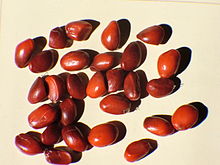Honokiol

| |
| Names | |
|---|---|
| Preferred IUPAC name
3′,5-Di(prop-2-en-1-yl)[1,1′-biphenyl]-2,4′-diol | |
| Other names
houpa, hnk
| |
| Identifiers | |
3D model (
JSmol ) |
|
| ChEMBL | |
| ChemSpider | |
ECHA InfoCard
|
100.122.079 |
| KEGG | |
PubChem CID
|
|
| UNII | |
CompTox Dashboard (EPA)
|
|
| |
| |
| Properties | |
| C18H18O2 | |
| Molar mass | 266.334 g/mol |
| Appearance | White solid |
| sparingly (25 °C) | |
| Related compounds | |
Related biphenols
|
diethylstilbestrol, dihydroxyeugenol |
Related compounds
|
magnolol. 4-O-Methylhonokiol |
Except where otherwise noted, data are given for materials in their standard state (at 25 °C [77 °F], 100 kPa).
| |
Honokiol is a
Biology
Honokiol has been extracted from a number of species of Magnolia native to many regions of the globe. Magnolia grandiflora, which is native to the American South, as well as Mexican species like Magnolia dealbata have been found to be sources of honokiol.[1] Traditionally in Asian medicine, the Magnolia biondii, Magnolia obovata, and Magnolia officinalis are commonly used.[2] The compound itself has a spicy odor.
Because of its physical properties, honokiol can readily cross the
Chemistry
Structure
Honokiol belongs to a class of neolignan biphenols. As a polyphenol it is relatively small and can interact with cell membrane proteins through intermolecular interactions like
Purification
There are several methods for purifying and isolating honokiol. In nature, honokiol exists with its structural isomer
Figure 1

Additionally a rapid separation approach was published in the Journal of Chromatography A in 2007. The process uses high-capacity high-speed countercurrent chromatography (high-capacity HSCCC).[5] Through this method honokiol can be separated and purified to above 98% purity with a high yield in under an hour.
History
Traditional medicine

Extracts from the bark or seed cones of the Magnolia tree have been widely used in traditional medicine in China, Korea, and Japan.[2]
Magnolia bark has traditionally been used in Eastern medicine as analgesic and to treat anxiety and mood disorders.[2][6] In traditional Chinese medicine, magnolia bark is called Houpu and is most commonly taken from two species, Magnolia obovata and Magnolia officinalis.[7] Some Chinese traditional formulas containing Houpu include Banxia Houpu Tang (半夏厚朴丸), Xiao Zhengai Tang, Ping Wei San(平胃散) and Shenmi Tang.[2] Japanese Kampo formulas include, Hange-koboku-to (半夏厚朴湯) and Sai-boku-to (柴朴湯).[2][6]

Western medical research
This section needs more primary sources. (June 2014) |  |
Honokiol is a
Side effects and contraindications
Research has shown a limited side effect profile for honokiol, and it appears to be well tolerated. However, its antithrombotic effects could cause hemorrhage especially in patients with conditions that would put them at a higher risk like
Pharmacology
Antitumorigenic activities
Honokiol has shown pro-
Neurotrophic activity
Honokiol [
Antithrombotic activity
Honokiol inhibits platelet aggregation in rabbits in a dose-dependent manner, and protects cultured RAEC against oxidized low density lipoprotein injury. Honokiol significantly increases the prostacyclin metabolite 6-keto-PGF1alpha, potentially the key factor in honokiol's antithrombotic activity.[19]
Anti-inflammatory activity
Studies examining honokiol as a protective therapy against
Antioxidant activity
Honokiol has also been proposed as an antioxidant. The compound protects against lipid peroxidation by interfering with ROS production and migration.[20] Accumulation of ROS extracellularly causes macromolecular damage while intracellular accumulation may induce cytokine activation.
Cytotoxicity inhibition
One way that honokiol acts as a neuroprotective is through cellular regulation and subsequent inhibition of cytotoxicity. Two mechanisms used to achieve this inhibition are GABAA Modulation and Ca2+ Inhibition. Cytotoxicity inhibition may be the neuroprotective mechanism of honokiol. Honokiol has also been shown to inhibit repetitive firing by blocking
GABAA modulation

It is believed that honokiol acts on
Ca2+ inhibition
A high concentration of Ca2+ induces
Antiviral activity
Honokiol has been shown to inhibit
Metabolic activity
Honokiol was shown to normalize blood glucose levels and prevent body weight gain in diabetic mice by acting as agonist of PPARgamma.[26]
Pharmacokinetics
The pharmacokinetics of honokiol have been explored in rats and mice; however, further research must be done in humans.[27] Intravenous delivery of 5–10 mg/kg in rodent models has shown a plasma half-life of around 40–60 minutes while intraperitoneal injections of 250 mg/kg had a plasma half-life around 4–6 hours with maximum plasma concentration occurring between 20 and 30 minutes.[1][28]
Delivery methods
Honokiol is most commonly taken orally. There are a number of supplements available containing honokiol. Magnolia tea made from the bark of the tree is also a common delivery method of honokiol.[citation needed] Both Native Americans and Japanese medicine use tea gargles to treat toothaches and sore throats.[29] Because honokiol is highly hydrophobic it must be dissolved in a lipid for many delivery methods. In many current animal studies the compound is dissolved in a lipid emollient and delivered through intraperitoneal injection. There is ongoing[when?] work developing liposomal emulsions for IV delivery.[27]
References
- ^ PMID 2406271.
- ^ PMID 21277893.
- PMID 21559510.
- ^ PMID 16722664.
- PMID 17222860.
- ^ S2CID 207485984.
- PMID 9461663.
- PMID 19203212.
- S2CID 30716241.
- ^ PMID 11934579.
- PMID 21449214.
- PMID 24179537.
- S2CID 22184445.
- PMID 15870175.
- PMID 15802533.
- PMID 12816951.
- PMID 19483651.
- PMID 21867920.
- PMID 16115372.
- ^ S2CID 44974515.
- ^ S2CID 10051483.
- PMID 20192217.
- PMID 16631734.
- PMID 21561750.
- S2CID 22428079.
- PMID 23811337.
- ^ PMID 23444779.
- PMID 8061832.
- ISBN 978-1-57912-392-5.
External links
- Heal Magnolias, Emory Magazine, Spring 2004
